Review: Kindle Paperwhite (3G) | TechTree.com
Review: Kindle Paperwhite (3G)
A competent, well designed, and solidly built e-book reader that's sadly too expensive for the improvements offered.
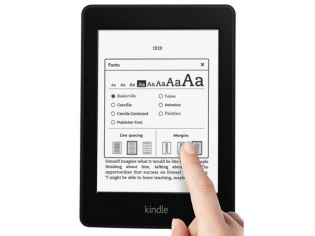
Solidly built; excellent plastic quality; responsive capacitive touchscreen; intuitive touch-optimised UI; brilliant illuminated display.
Ridiculously expensive; battery drain due to indexing issues; 3G connectivity erratic, can't be used for web browsing; no audio support; only 1.25 GB of usable space.
My opinion of the Kindle e-book reader was coloured by old-school scepticism and a general disregard for any battery-powered device that aims to mimic paper by the means of a display. I mean, I couldn't think of anything that had a battery, and didn't outright suck. Reading on any kind of display had been an outright painful endeavour in my experience. Plonking thousands of bucks down on an e-book reader, then, seemed out of the question. That is, until I was gifted a fourth-generation Kindle.
Amazon's e-book reader pretty much shattered my preconceived notions, and proved its worth as an alternative to paperback. For starters, its electrophoretic ink technology faithfully mimics paper and causes zero eye strain unlike conventional emissive/transmissive displays. Battery life isn't an issue either. The display requires a miniscule amount of power to realign the pigments in the microcapsules, and display text as well as pictures. Once an image is formed, no additional power is needed to hold it. Sounds just about perfect then.
In essence, an e-ink enabled e-book reader has all the goodness of paperback sans the bulk and unwieldiness. Moreover, you can not only carry hundreds of books, but also search, highlight, annotate, and look up words instantaneously while you are at it. Having used the Kindle for over a year now, I am fully convinced and satisfied of its utility and worth. What needs to be seen, however, is if the new Kindle Paperwhite proves to be a fitting upgrade to the fourth-generation model.
This is a Herculean task since the Wi-Fi only version of last gen Kindle costs Rs 6,000, whereas the equivalent Paperwhite variant sells for almost twice as much at Rs 11,000. The one being reviewed here is the 3G version that commands an eye watering Rs 14,000. However, these are prices from Amazon's Indian portal. Sucking up to a benevolent NRI uncle, on the other hand, can save you a substantial amount of money. That is, provided you can convince him to serve as a mule fetching you an ad supported (and, more importantly, duty-free) version of the Kindle. The adverts aren't intrusive as they appear only as a small bar in the index section. They are definitely worth the savings, though.
Design and Build Quality
The Paperwhite is not only slimmer than the last-gen Kindle Touch, its physical dimensions of 169 mm x 117 mm x 9.1 mm (L x W x D) are merely a few millimetres larger than the non-touch version I own. In fact, the size difference isn't noticeable even when you compare them side-by-side. This is remarkable considering the fact that the new model crams in a touchscreen and requisite hardware, in addition to another layer of illumination without getting too bulky. The weight, however, at 222 grams is a wee bit more than my non-touch, last-gen version tipping the scales at 170 grams. Once again, you'd be hard pressed notice the 50-gram difference on a device as large as this.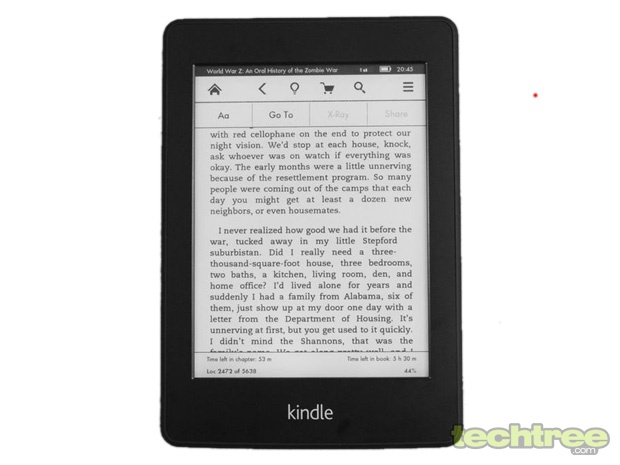
However, numbers can't do justice to how well-built and cleverly designed the Paperwhite feels. Prima facie, both variants may look the same, but the devil is in the details. Subtle design cues such as reduced number of seams and joints point to significantly improved build quality. The almost imperceptibly rounded edges don't seem like much at a glance, but the difference was clearly palpable once I held both the Kindles in my hand. The smoothened edges when combined with generously rubberised plastics make the Paperwhite feel delightfully comfortable, while also rendering it harder to slip through sweaty hands.
The touchscreen display ensures that the front fascia is devoid of menu and navigation buttons of the fourth-gen model, which now looks relatively cheap and unsightly in comparison to the Paperwhite. Despite the lack of physical buttons, the device excels at one-handed usage thanks to clever navigation design. By allocating a thin gutter along the left edge of the touchscreen to flip backwards and the rest of the screen to move forward, the Paperwhite makes it easy to navigate with just your left thumb. In case you prefer holding the device in your right hand, you can always resort to using gestures that let you swipe intuitively through the pages as well. The capacitive touchscreen on the Paperwhite is leagues ahead of the IR-based alternative on the last-gen model. It's accurate, responsive, and makes navigation an absolute pleasure.
The lone power button flanking the micro-USB port has been carried over from the last model. My only grouse here is that the Amazon only throws in a micro-USB cable, but no wall charger. This is frankly ridiculous considering the Rs 14,000 sticker price. Being able to charge a mobile device without accessing a computer is more a necessity than luxury.
Display: Putting the White in Paperwhite
I have already explained how Amazon's implementation of the e-ink display works, and the fact that it works quite competently as well. The main USP of the Kindle Paperwhite is a brand new display itself. For starters, its 212 ppi resolution is significantly higher than 167 ppi of the last-gen Kindle. You are hard pressed to notice the improvement when it comes to text, though.
What really makes a difference, however, is Paperwhite's ability to force the screen to refresh at every turn of the page. The older versions would make incremental localised changes for five consecutive pages, before refreshing the entire screen on the sixth page. While this conserves battery, the screen quality gradually degrades thanks to ghosting and residual artefacting by the time you reach the sixth page. The Paperwhite forced refresh feature provides an option to ensure top-notch image quality each time you flip a page, albeit by sacrificing a bit of battery life and page refresh speed. Having said that; the latest iteration of Kindle renders pages noticeably faster than any of its predecessors.


Kindle Paperwhite (left), Kindle 4G after five incremental page refreshes (centre), and Kindle 4G after full page refresh (right)
The inclusion of screen illumination is really what gives the Paperwhite its name. An e-ink screen isn't a transmissive display technology, and that's primarily why traditional backlighting is useless in this case. A display that's designed to mimic paper must be illuminated like one too. The solution is front-lit screen, which is achieved by sandwiching the touchscreen between the e-ink display at the bottom and a light diffusion system similar to that employed in any edge-lit LED display.
A front-lit screen, however, is easier said than done. If you have ever taken apart an LCD panel and witnessed the backlight diffusion panel in all its naked glory, you'll have noticed its milky translucence. This lack of transparency is the reason why it's placed behind the LCD panel and not between the viewer and the panel, which is exactly how it is oriented in the Paperwhite. To overcome these odds, the Amazon engineers spent two years perfecting a specialised diffusion panel dubbed as the Lightguide. It is unique because this is a light diffusion panel that's perfectly transparent.
The Lightguide is essentially a fibre optic cable flattened out into a sheet that leverages nano-imprinted diffraction patterns to achieve uniform distribution of light without compromising on transparency. This allows the screen to be lit uniformly with just four low-power LED lights placed along the bottom edge of the screen. Unfortunately, the illumination isn't exactly uniform where the LEDs are placed, but that's something you'll notice only in a room with zero ambient lighting; that too, if you really pay attention to the fact.
The front-lighting is essentially what endows the Paperwhite's screen with a characteristically white look of paper. This is much unlike the dull greyish background of the older displays. The level of contrast achieved by this means is a revelation, and it makes the screen look delightfully pleasing to the eyes. With 24 levels of front-light adjustment, you can achieve the desired brightness and contrast levels whether you are in a pitch dark or a brightly lit room. The best part is that, contrary to my initial apprehension, at no point of time does the illumination cause any iota of eye strain. On the contrary, it enhances contrast and helps your eyes relax even under poor ambient lighting conditions.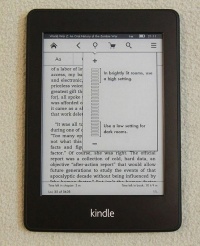
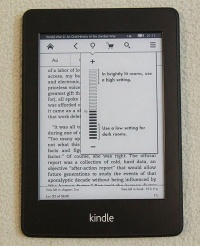
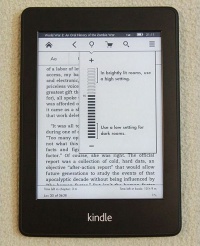
User Interface, Features, and Connectivity
The touchscreen optimised UI on the Paperwhite has been further tweaked to deliver faster response and embody intuitive gesture-based controls. Skipping pages and scrolling through lists is now just a matter of swiping your fingers. The capacitive touchscreen is pleasantly responsive and tracks your fingers (with two-point tracking for pinch zooming) faithfully with every swipe and tap. The basic UI consists of a menu bar at the top of the screen that can be invoked by tapping the top of the panel. The menu includes icons providing quick access to Homescreen, Kindle Store, search function, and lighting adjustment. This is in addition to a drop-down menu for more options to change orientation, bookmarking, notes, collection management, and settings among other things.
While reading a book, you get an additional menu bar with options to adjust fonts and text margins, the Go To menu to navigate between chapters, in addition to two new features dubbed X-Ray and Share. The latter is a self explanatory addition that allows you to, well, highlight quotes or passages and share them with your Friends/Followers once you link your Facebook and Twitter accounts to the device.
The X-Ray feature is Kindle's equivalent of director's commentary and other annotations found on Blu-ray version of movies. Depending on the book, it may include additional information on the characters, trivia, in depth analysis of underlying themes—all available across the current page and down to the individual chapters or the entire book as a whole. Since this feature is delivered as an extra download along with the e-book, you don't need internet connectivity or have to put up with any delay to fetch the extra information. Unfortunately, as of now, not many e-books support this feature.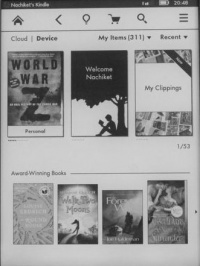

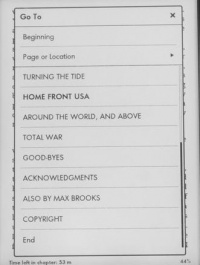
The touch-optimised UI looks good and works equally well
The persistent progress bar found at the bottom in older Kindles has now been replaced by a smarter status bar. It keeps a track of your reading speed and calculates the time required to finish the current chapter or the entire book, in addition to displaying the progress in percentage. You can also choose which one of these parameters are displayed in the status bar: location, time left in chapter, or time left in book. Moreover, invoking the menu expands the status bar to display all these metrics at the same time. I must say, I quite enjoy being spoiled for choice here.
The on-screen keyboard is sufficiently large and accurate enough to prevent typos, but the slow screen response leads to omitted keystrokes. However, that is only if you type frantically like you would on your smartphone. The experimental browser, too, is unwieldy. Then again, this is an e-book reader and not a tablet. Moreover, you can't even surf the internet on the move since you are barred from using the free 3G connectivity for browsing.
Speaking of which, the 3G connectivity is carrier locked and absolutely free of charge. Which on one hand is pretty awesome to say the least, since the device allows you to sync bookmarks, annotations, and reading progress on the cloud and sync it across compatible devices. On the other hand, though, that's about all you can do with the connection. Amazon restricts access to the experimental browser on 3G to prevent abuse of free internet connectivity. So unless you plan to browse Wikipedia, you need a Wi-Fi connection to surf the internet. At any rate, the browser's unwieldiness and the slow refresh rates make it pretty much a pain to use.
The 3G performance was a mixed bag. It ranged from poor coverage and locked 2G speeds, to excellent reception and speedy 3G downloads. The former was experienced outside Bombay city limits and when travelling in trains and buses. That ironically defeats the purpose of getting a 3G model, especially since you'd ideally want to use it on the move. For a premium of Rs 3,000, the 3G model doesn't make a case for itself at all. The Wi-Fi component works as advertised, though, and lets you use the experimental browser for a change. I had absolutely no difficulty registering the Kindle in my encrypted home and office networks. The smart money is definitely on the Wi-Fi model here.
Battery Life and Verdict
The five-crore question is how much of an impact does illumination have on the Paperwhite's battery life. Amazon claims an uptime of eight weeks calculated at a usage of 30 minutes a day with Wi-Fi switched off and the light level set at ten. The total uptime, however, is affected by the following parameters: LED brightness level, Wi-Fi/3G usage, and whether you have forced the device to update the screen at every flip of the page. Depending on these factors, the battery life ranges from as little as 13 hours when everything turned to the max, to 50 hours if you are frugal with aforementioned parameters.
Having said that, having too many books loaded onto the device will tax the processor and drain battery life, especially if you have one or more rogue books that can't be indexed. A simple way to identify and eliminate the problem is to search random gibberish, which shows an error message along with books that are currently being indexed. Perform a similar search later. This time if you find the same books being indexed, you are better off deleting them.
The Kindle Paperwhite does all that its predecessors did, and it does it well. This includes support for TXT, PDF, MOBI, PRC, HTML, DOC, DOCX, JPEG, GIF, PNG, and BMP formats, in addition to Kindle's own ebook format (AZW). The popular open EPUB format is still conspicuous by its absence though. Unfortunately, just like its elder fourth-gen sibling, it packs in just 2 GB of storage, of which only 1.25 GB is available. While that's good for over a thousand e-books, this parsimony is deplorable considering its Rs 14,000 price tag.
Fans of audio books and text-to-speech feature will be disappointed with the lack of a speaker/headphone jack and accompanying audio processing circuitry. I personally don't believe the device would have been appreciably thicker or heavier, even if it had included the feature. Pair that with the lack of a wall charger, and you begin to wonder if Amazon's given you a raw deal at Rs 14,000.
There's no easy way to put this. The Kindle Paperwhite 3G makes little sense at a premium of Rs 8,000 over the last-gen variant that sells for Rs 6,000. Even the Wi-Fi only version available at Rs 11,000 seems overpriced, because you essentially pay Rs 5,000 for a touchscreen and illumination. Yes, the Paperwhite is solidly built, sports an excellent UI, responsive touchscreen, and a stellar front-lit display, but even then the improvement over the outgoing model doesn't quite justify the premium. I would say, stick to the cheaper fourth-gen Wi-Fi model unless you absolutely want a touchscreen and the ability to read in the dark without ambient lighting or external light attachments.
Features: 3/5
Design and Build Quality: 4/5
Performance: 4/5
Value For Money: 2/5
Mojo: 4/5
Overall Rating: 3.5/5
- DRIFE Begins Operations in Namma Bengaluru
- Sevenaire launches ‘NEPTUNE’ – 24W Portable Speaker with RGB LED Lights
- Inbase launches ‘Urban Q1 Pro’ TWS Earbuds with Smart Touch control in India
- Airtel announces Rs 6000 cashback on purchase of smartphones from leading brands
- 78% of Indians are saving to spend during the festive season and 72% will splurge on gadgets & electronics
- 5 Tips For Buying A TV This Festive Season
- Facebook launches its largest creator education program in India
- 5 educational tech toys for young and aspiring engineers
- Mid-range smartphones emerge as customer favourites this festive season, reveals Amazon survey
- COLORFUL Launches Onebot M24A1 AIO PC for Professionals







TECHTREE